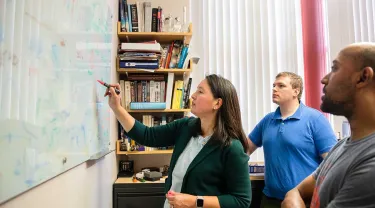Tuberculosis (TB), the second-leading infectious killer in the world, affects 10 million people worldwide and kills 1.5 million each year. Because the disease’s bacteria behave differently in different environments—and in some cases, evolve to become drug-resistant—effective treatment requires a combination of three or four drugs. But there are 20 possible compounds care providers can use, offering nearly 6,000 different combinations and making it challenging to know what combinations to use when.
Promising new antibiotics aimed at tuberculosis have been developed in recent years. But researchers and drug developers have been challenged to find ways to cheaply and effectively determine which drugs will work best in combination. It’s a mathematically complex, expensive, and time-consuming process using traditional procedures, said Bree Aldridge, associate professor of molecular biology and microbiology at Tufts University School of Medicine.
For a data-driven solution to this challenge, Aldridge and her fellow researchers turned to machine learning. Their approach allows consideration of novel drug combinations at a new scale, potentially increasing the speed at which scientists determine which drug combinations will most effectively treat TB.
To develop their new approach, researchers relied on data from large studies that contained laboratory measurements of two- and three-drug combinations of 12 commonly used antituberculosis drugs. Using mathematical models and artificial intelligence, the team discovered a set of rules that drug pairs need to satisfy in order to be potentially good treatments.
The goal, then, Aldridge said, is to find new cocktail combinations that work as well as or better than the existing mix and to find treatment combinations that work more quickly than four to six months. And the new modeling system and the use of drug pairs (rather than combinations of three or four drugs) does cut down significantly on the amount of testing that needs to be done before moving a drug pair into further study.
With multidrug-resistant TB on the rise, and the ever-present risk of people with TB not taking the drugs consistently for a long period of time, the need for this new approach is urgent. Aldridge sums up the benefits this way: “This system we developed should make the process of achieving our goal faster and cheaper.”
Pictured above: Bree Aldridge (center) with colleagues at the School of Medicine
